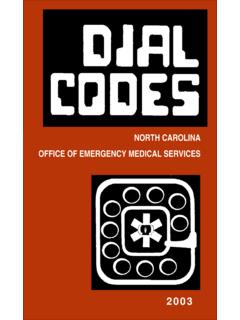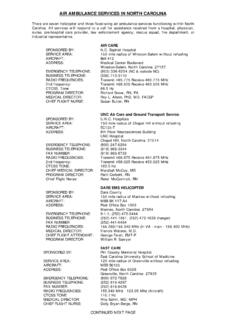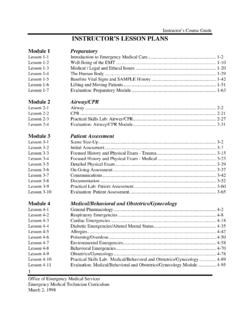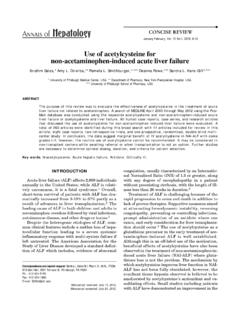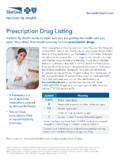Transcription of North Carolina Medical Board Approved …
1 North Carolina Medical Board Approved Medications for Credentialed EMS Personnel EMS personnel at any level who administer medications must do so within an EMS system that provides Medical oversight. Personnel must follow written treatment protocols and must complete appropriate Medical education. All EMS System protocols and policies must be reviewed and Approved by the Medical Director of the Office of EMS. Medications FR MR EMT EMT-I EMT-P. ACE inhibitors X. Acetaminophen X X X X. Adenosine X. Aminophylline X. Amiodarone X. Antibiotics X. Anti-emetic preparations X. Aspirin X X X. Atropine X4 X4 X4 X. Barbituates X. Benzodiazepine preparations X. Beta agonist preparations X2 X X. Beta blockers X. Bretylium X. Calcium channel blockers X. Calcium chloride/gluconate X. Charcoal X X X. Clonidine X. Clopidogrel X. CroFab (Crotalidae Polyvalent Immune Fab) X8. Crystalloid solutions X X. Cyanide poisoning antidote kit X. Digoxin X.
2 Diphenhydramine X3 X X. Dobutamine X. Dopamine X. Droperidol X. Epinephrine X1 X1 X X. Etomidate X. Flumazenil X. Furosemide X. Glucagon X X. Glucose solutions X X. Haloperidol X. Heparin (unfractionated and low molecular weight) X X. Histamine 2 blockers X X. Hydroxocobalamin X. Immunizations X6 X6. Insulin X. Ipratropium X X. Isoproterenol X. Ketamine X7. Lidocaine X. Magnesium sulfate X. Last revision: December 1, 2014 1. Previous revisions 12/2014, 10/2014, 04/2014, 07/2013, 02/2013, 08/2012, 03/2012; 01/2009; 10/2008; 11/2007; 5/2006; 06/2005; 12/2004. Medications FR MR EMT EMT-I EMT-P. Mannitol X. Methylene blue X. Milrinone X. N-acetylcysteine X. Narcotic analgesics X. Narcotic antagonists X10 X9 X9 X X. Nasal spray decongestant X X X. Nesiritide X. Nitroglycerin X2 X X. Nitroprusside sodium X. Nitrous oxide X. Non-prescription medications X X X. Non-steroidal anti-inflammatory X X X. Norepinephrine X. Octreotide X.
3 Oxygen X5 X5 X5 X5. Oxytocin X. Paralytic agents X7. Phenothiazine preparations X. Phenylephrine X. Phenytoin preparations X. Plasma protein fraction X. Platelet g-II/IIIa inhibitors X. Potassium chloride X. Pralidoxime X4 X4 X4 X. Procainamide X. Procaine X. Proparacaine X. Propofol X8. Proton pump inhibitors X. Sodium bicarbonate X. Steroid preparations X. Thiamine X X. Thrombolytic agents X. Topical hemostatic agents X X X X X. Total Parenteral Nutrition X. Tranexamic Acid (TXA) X11. Tuberculosis skin test X6 X6. Valprocic acid X. Vasopressin X X. Whole blood and components X. Ziprasidone X. 1. MR and EMT use of epinephrine is limited to the treatment anaphylaxis and may be administered only by auto injector, unless Approved by EMS System Medical Director and OEMS. 2. EMT use of beta-agonists and nitroglycerine is limited to patients who currently are prescribed the medication. EMTs may administer these medications from EMS supplies.
4 EMT use of beta-agonists may be through any inhaled method of medication administration. 3. EMT administration of diphenhydramine is limited to the oral route. 4. As a component of preparedness for domestic terrorism, EMS personnel, public safety officers, and other first responders recognized by the EMS system, may carry, self-administer, or administer to a patient atropine and/or pralidoxime, based on written protocols and Medical direction. All personnel except for EMT-Ps must administer these medications by an auto injector. 5. Administration of oxygen does not require Medical direction. 6. Administration of immunizations and TB skin tests are not limited to public health initiatives. 7. Can only be used as induction agent for RSI or for post intubation sedation. Last revision: December 1, 2014 2. Previous revisions 12/2014, 10/2014, 04/2014, 07/2013, 02/2013, 08/2012, 03/2012; 01/2009; 10/2008; 11/2007; 5/2006; 06/2005; 12/2004.
5 8. Can only be used for interfacility transport where infusion has already been started at transferring facility. EMS units cannot carry Propofol or CroFab. This medication must be provided by the transferring hospital. 9. MR & EMT's administration of Naloxone is limited to the intra-nasal (IN) route. 10. First Responder agencies, to include law enforcement are allowed to administer Naloxone with the following requirements: a. They must administer the Naloxone under the Medical oversight of the County EMS Medical Director, and be incorporated into the respective EMS System in which they are administering the Naloxone. b. They must receive appropriate training and continuing education as Approved by the County EMS Medical Director. c. The Naloxone must be administered as part of a protocol and procedure Approved by the County EMS Medical Director, and the NC Office of EMS. d. All administration of Naloxone must be reviewed by the EMS Peer Review/Quality Management Committee of the EMS.
6 System, which functions under the supervision of the local County EMS Medical Director. 11. For an EMS System to use Tranexamic Acid (TXA), they must submit for approval by the OEMS State Medical Director a signed letter from any Trauma Centers that would be the recipient of the patient that the destination Trauma Center agrees with its use and will give the 2nd required dose of Tranexamic Acid (TXA). Last revision: December 1, 2014 3. Previous revisions 12/2014, 10/2014, 04/2014, 07/2013, 02/2013, 08/2012, 03/2012; 01/2009; 10/2008; 11/2007; 5/2006; 06/2005; 12/2004. North Carolina Medical Board Approved Skills for Credentialed EMS Personnel EMS personnel performing these skills must do so within an EMS system. Personnel must follow written treatment protocols and must complete appropriate Medical education. All EMS System protocols and policies must be reviewed and Approved by the Medical Director of the Office of EMS.
7 Skills LEO EMD MR EMT EMT-I EMT-P. 12-Lead ECG acquisition & transmission X X X. 12-Lead ECG interpretation X. Airway-Blind Insertion Device X2 X X. Airway-CPAP X X. Airway-Cricothyrotomy-Needle X. Airway-Cricothyrotomy-Surgical X. Airway-Intubation X X. Airway-Rapid sequence induction X. Airway-Suction X X X X. Airway-Tracheostomy tube change X X. Arterial Access-Blood Draw X. Arterial Line maintenance X. Capnography (waveform) X. Carbon Monoxide Measurement (non-invasive) X X X X. Cardiac Pacing X. Cardiopulmonary Resuscitation X X X X X. Cardioversion X. Carotid Massage X. Central Venous Pressure line maintenance X. Chest Compression-External Device X X. Chest Decompression-Needle X. Chest Tube Maintenance X. Defibrillation-Automated X X X X X. Defibrillation-Manual X. Epidural Catheter maintenance X. Gastric Intubation X. Glucose Measurement X X X X. Intra-Ventricular Catheter maintenance X. Intubation Confirmation-Capnometry (color) X X.
8 Intubation Confirmation-Esophageal Bulb X X. Medication Administration X3 X3 X3 X3 X3. Orthostatic Blood Pressure X X X X. Oxygen Administration X X X X X. Patient Assessment X X X X. Pulse Oximetry X X X X. Reperfusion Checklist X X X X. Respirator Operation X X X. Restraints X X X X. Spinal Immobilization X X X X. Splinting X X X X. Stroke Screen X X X X. Swan-Ganz Catheter maintenance X. Thermometer (oral & rectal with low temperature capability) X X X X. Urinary Catheterization X. Last revision: December 1, 2014 4. Previous revisions 12/2014, 10/2014, 04/2014, 07/2013, 02/2013, 08/2012, 03/2012; 01/2009; 10/2008; 11/2007; 5/2006; 06/2005; 12/2004. Skills LEO EMD MR EMT EMT-I EMT-P. Venous Access-Blood Draw X X. Venous Access-Existing catheters X. Venous Access-Femoral Line X. Venous Access-Intraosseous X. Venous Access-Peripheral X X. Ventilator Operation X. Wound Care X X X X. Pre-arrival instructions to callers X1.
9 Determine and dispatch appropriate EMS system resources X1. 1. All EMD skills must be performed in EMS systems with Medical oversight and written EMD protocols. 2. EMTs using blind insertion airway devices must be functioning in EMS systems with Medical direction and written treatment protocols. 3. EMS personnel at any level who administer medications must do so within an EMS system that provides Medical oversight. Personnel must follow written treatment protocols and must complete appropriate Medical education. All EMS System protocols and policies must be reviewed and Approved by the Medical Director of the Office of EMS. The Approved medication list is found at the beginning of this document. The administration of oxygen does not require Medical direction. Last revision: December 1, 2014 5. Previous revisions 12/2014, 10/2014, 04/2014, 07/2013, 02/2013, 08/2012, 03/2012; 01/2009; 10/2008; 11/2007; 5/2006; 06/2005; 12/2004.

